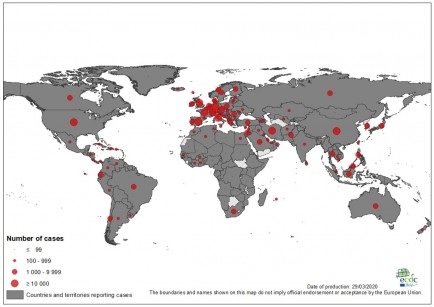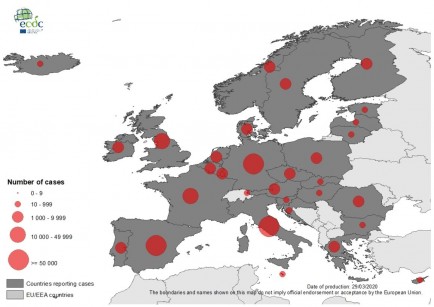Cover up and disinfect
If you’re sick, the CDC says to use a face mask around other people, such as when going to the doctor or hospital.
“If you are not able to wear a face mask (for example, because it causes trouble breathing), then you should do your best to cover your coughs and sneezes, and people who are caring for you should wear a face mask if they enter your room,” the CDC says.
If you are running short on face masks, or don’t have any because of hoarding, try to protect the caregiver as best you can, the CDC says.
Altmann stresses maximizing isolation and protective actions.
“You can have a healthy person leave the sick one food and drinks at the door, and then go wash their hands,” Altmann explained. “Wear gloves to pick up the empty plates, take them back to the kitchen and wash them in hot water with soap, or preferably with a dishwasher, and wash your hands again.”
Do not share drinking glasses, cups, forks or other eating utensils or dishes, the CDC says. Don’t share towels or bedding with other people in your home. When doing laundry, don’t shake the sick person’s dirty clothes to “minimize the possibility of dispersing virus through the air.”
And caregivers should wear disposable gloves when handling that dirty laundry, the CDC says, throwing them away after each use.
“If using reusable gloves, those gloves should be dedicated for cleaning and disinfection of surfaces for Covid-19 and should not be used for other household purposes. Clean hands immediately after gloves are removed,” the CDC advises.
Dedicate a lined trash can for any tissues or other paper or disposable products used by a sick person, the CDC says, adding that caregivers should “use gloves when removing garbage bags, handling and disposing of trash. Wash hands after handling or disposing of trash.”
One last, very important thing: Call 911 immediately if you or your loved ones have any of these symptoms: increased or sudden difficulty breathing or shortness of breath; a persistent pain or pressure in the chest; and any sign of oxygen deprivation, such as new confusion, bluish lips or face, or you can’t arouse the sick person.
While these are key danger signs, this is not an exhaustive list, says American Medical Association president Dr. Patrice Harris, so call if anything concerns you.
“If the symptoms don’t get better or they worsen you should call your health care provider, the urgent care or the emergency department,” Harris said. “And if the shortness of breath is severe, immediately call 911.”
Keeping everyone else from getting sick
Try to keep an air flow in the rest of the home with opened windows or doors with screens, or with air conditioning. Have everyone wash their hands at every opportunity. Clean and disinfect all those commonly shared surfaces — don’t forget the refrigerator and microwave handles!
Keep everyone as stress free as possible — a hard task for sure — and focus on healthy eating, regular exercise and quality sleep.
Even though there is no indication that pets can give or get Covid-19, the CDC suggests keeping pets away from sick people.
“Since animals can spread other diseases to people, it’s always a good idea to practice healthy habits around pets and other animals,” the CDC says. “If you must care for your pet or be around animals while you are sick, wash your hands before and after you interact with pets.”
When is your quarantine over?
A recent study that analyzed data coming from China found the incubation period for the virus can range from 1 to 14 days, with 95% of the patients experiencing symptoms within 12.5 days of contact.
That falls in line with current US recommendations that require a two-week quarantine for anyone exposed to the virus. Keep this in mind when estimating an isolation period for family members who may have become sick after a loved one.
As for the person with the coronavirus symptoms, the CDC says you may be well when you “no longer have a fever (without the use medicine that reduces fevers), and other symptoms have improved (for example, when your cough or shortness of breath have improved), and you received two negative tests in a row, 24 hours apart.” Check with your health care provider for full instructions.
These are scary times, but hopefully these tips will help ease your anxiety and prepare you and your family for the worst, while hoping and striving for the best.
Original article: https://edition.cnn.com/2020/03/25/health/how-to-prepare-for-coronavirus-quarantine-wellness/index.html



























Comments